UNcovering The Results Behind Brand’s COVID-19 Campaigns: Part 2
COVID-19 has caused widespread disruption across the globe.
The spread of the coronavirus — and subsequent government lockdowns and social distancing measures around the world — has had a huge impact on consumer behaviours and attitudes.
Dealing with such an unprecedented situation has caused shockwaves across Adland, with advertisers understandably struggling to adapt to this uncharted territory.
Over the last few weeks, Unruly has been conducting a number of studies to help advertisers face the spread of COVID-19 with certainty.
As well as running global consumer surveys, we’ve also been using our emotional testing and targeting tool, UnrulyEQ, to discover how brands’ COVID-19 ad strategies have been received by consumers around the world.
In this blog, we look at UK reactions to coronavirus campaigns from supermarket chains Tesco and Sainsbury’s, plus a star-studded ad from broadcaster ITV and a spot from Jack Daniels.
The results were then compared to Unruly’s database of thousands of ads to discover not only the emotions people felt but the impact they had on various brand and business metrics.
We’ll continue to test brands’ creatives during the course of the pandemic. So stay tuned for more results.
Sainsbury’s – Help Stop The Spread
Sainsbury’s ad offers tips on how shoppers at the supermarket chain can help keep themselves, fellow shoppers and their staff safe during the spread of COVID-19.
Looking at the ad’s EQ Score — a composite score based on the intensity of emotions viewers felt while watching, plus a campaign’s ability to drive brand metrics such as brand favorability and purchase intent – it performed well, scoring 5.9 out of 10, compared to the UK average of 5/10.
Despite the creative being a very simple animation without any sound, it still packs an emotional punch, with feelings of warmth and pride both above the UK norm. Overall, the percentage of people who felt intense positive emotions while watching was 21.2%, which is slightly higher than the UK norm of 20.1%.
Unsurprisingly, 35% of viewers also came away from watching the video feeling very informed – more than 4x higher than the UK norm (8%).
The video was also effective at helping drive consumers to shop at Sainsbury’s, with purchase intent (41%), brand favourability (39%), brand recall (72%), people’s willingness to find out more (43%) and the percentage of brand promoters (29%) all above the UK norm.
Viewers were also a lot more likely to share the video (43%) compared to the UK average (26%). Very similar to the ads we tested in the US and Germany, the main drivers of consumers’ willingness to share the ad across their social networks was Zeitgeist, with 23% saying they would share it because the content defined the spirit and mood of the time, and social good (21%). The percentage of people willing to share the video to recommend Sainsbury’s to a friend or family (22%) was also well above the UK norm (13%).
You can see more results below:
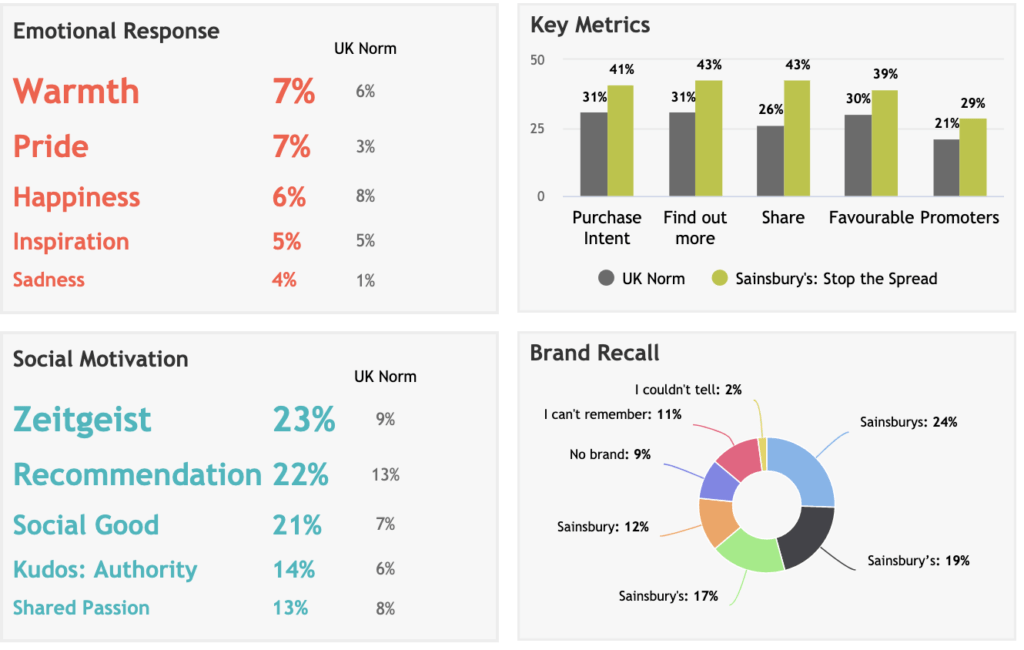
Tesco – Some Little Helps For Safer Shopping
But how did Tesco’s video’s performance compare to its rival Sainsbury’s? Both creatives look to do very similar things, letting the public know about its recommendations and measures it has taken to keep its staff and people shopping in their stores safe during the COVID-19 pandemic.
However, while Sainsbury’s went for a very simple animated creative with no sound, Tesco used real staff members to promote its safer shopping message.
So how did it compare? Well, overall the ad performed slightly better, managing an EQ Score of 6.6 out of 10.
Overall, the emotional blueprint is the same, with feelings of warmth, pride, inspiration and happiness the most prevalent emotions for both (albeit in slightly different orders). However, Tesco’s ad elicited slightly stronger emotional engagement overall — 23.7% of viewers felt intensely positive — which is probably to be expected from a video that includes actual people rather than animations.
Like Sainsbury’s video, the ad also performed better than the UK norm for all of the main brand and business metrics. Purchase intent (48%), brand recall (79%), find out more (45%), brand favourability (48%) and brand promoters (35%) were all higher than Sainsbury’s video.
Although, the number of people who came away feeling informed was slightly lower at 31%.
The ad’s content inspired almost half of its viewers (47%) to want to share it with their social networks, slightly more than Sainsbury’s (43%). The main motivations were also very similar only at slightly higher levels: Zeitgeist (27%), Recommendation (23%) and Social Good (23%).
So, overall, Tesco just pipped Sainsbury’s in overall execution of its content, but both ads’ messaging resonated strongly with consumers.
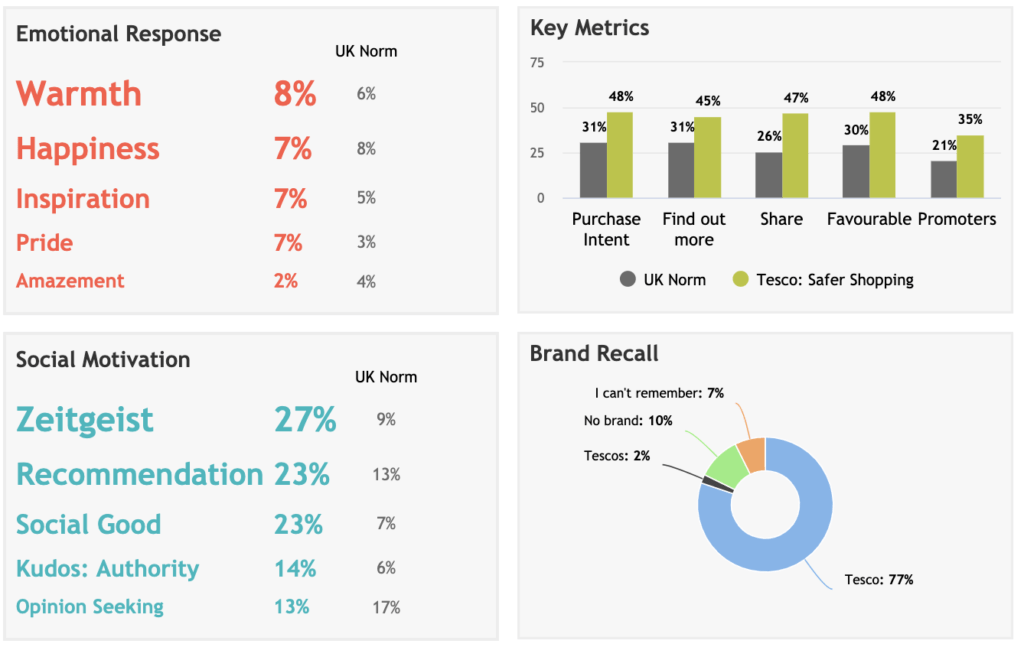
ITV – Apart. But Never Alone
ITV’s latest spot features a host of celebrities associated with the TV channel communicating a unified message of hope and togetherness during this difficult time via a string of home-recorded videos.
A massive 20% of respondents felt feelings of warmth while watching the video compared to the UK norm. The three other top emotions of happiness (16%), pride (16%) and inspiration (12%) also all scored way above the UK norm. This is likely down to viewers relating to the celebrities on screen who are going through the same experience as them while they self isolate and practise social distancing, combined with the video’s message of love, unity and positivity.
Looking at key business metrics, this ad overperformed across every metric, scoring a huge 49% for Find Out More versus a UK norm of 31%, an impressive 51% for shareability versus a 26% UK norm and 42% for purchase intent versus a 31% UK norm.
These are some of the most impressive business metrics we’ve seen from a UK ad, and they are reflected in its overall EQ score of 6.7, making it the most effective out of the four ads we tested.
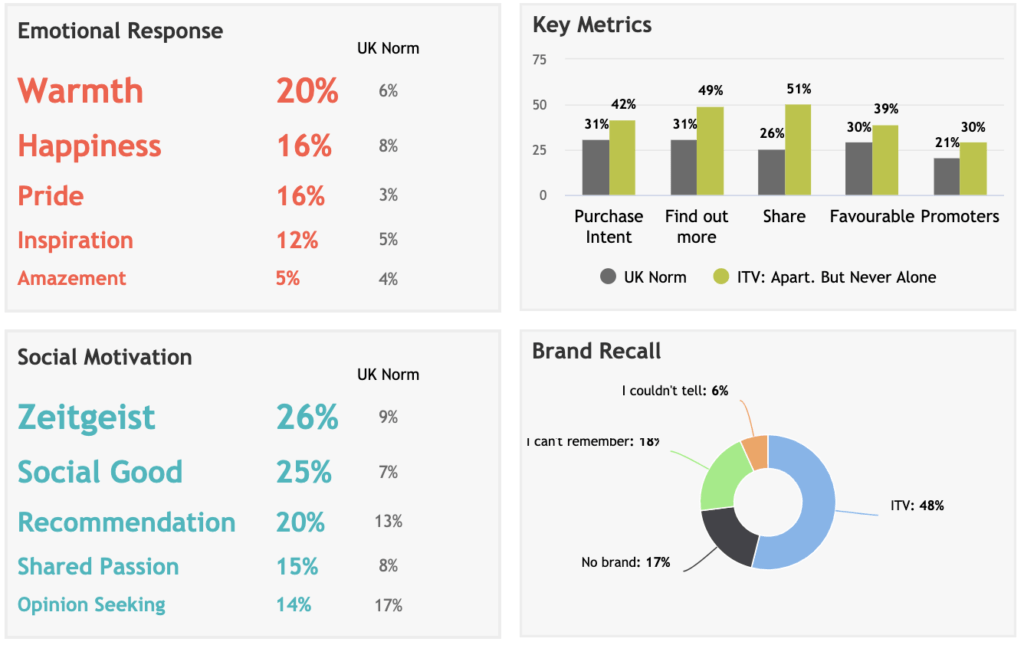
Jack Daniels – With Love, Jack
In its spot Jack Daniels goes with a similar format to ITV’s video, showing a string of videos of people isolating themselves in their homes.
The difference with this ad is it shines a light on normal people and how they’re finding innovative ways to communicate without physically being together. This includes a virtual chess game, a window game of noughts and crosses, singing together over webcam and, of course, enjoying a few glasses of Jack Daniels together.
Again, this ad evoked a number of positive emotions, scoring 19% for warmth versus a UK norm of 6%, 15% for happiness versus a UK norm of 8%, and 9% for inspiration versus a 5% UK norm.
Similar to ITV, this combination of positive emotions is likely down to viewers relating to the people they in the ad see self-isolating, while the high levels of warmth are likely associated with seeing friends and family members connecting with each other and having fun, helping each other through a difficult time.
This ad also performed above the norm for all key business metrics, scoring 48% for shareability versus a 26% UK norm, 43% for Find Out More versus a 31% UK norm and 42% for purchase intent versus a 31% UK norm.
When asked what the main motivation for sharing on social media was, similar to the other ads in this lineup, the most popular answer was Zeitgeist (26%). From the verbatims people provided, we can see that a number of consumers said they would share the video because it made them smile and they can imagine it doing the same for others who watch it.
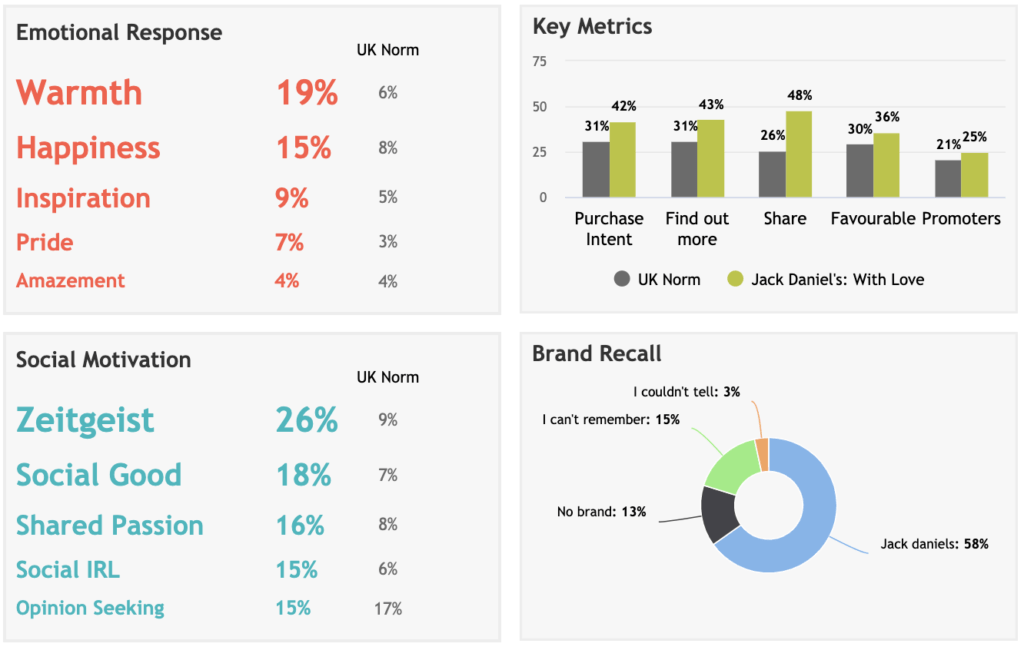
As you can see from the below chart, when we consider the combination of positive emotions evoked, along with the high levels of performance all key business metrics, all of these ads performed extremely well. This reinforces the fact that as a brand, you should be thinking very carefully about how you communicate with consumers during this time.
Landing the right message can be extremely effective and have a critical impact on your brand during this uncertain time.
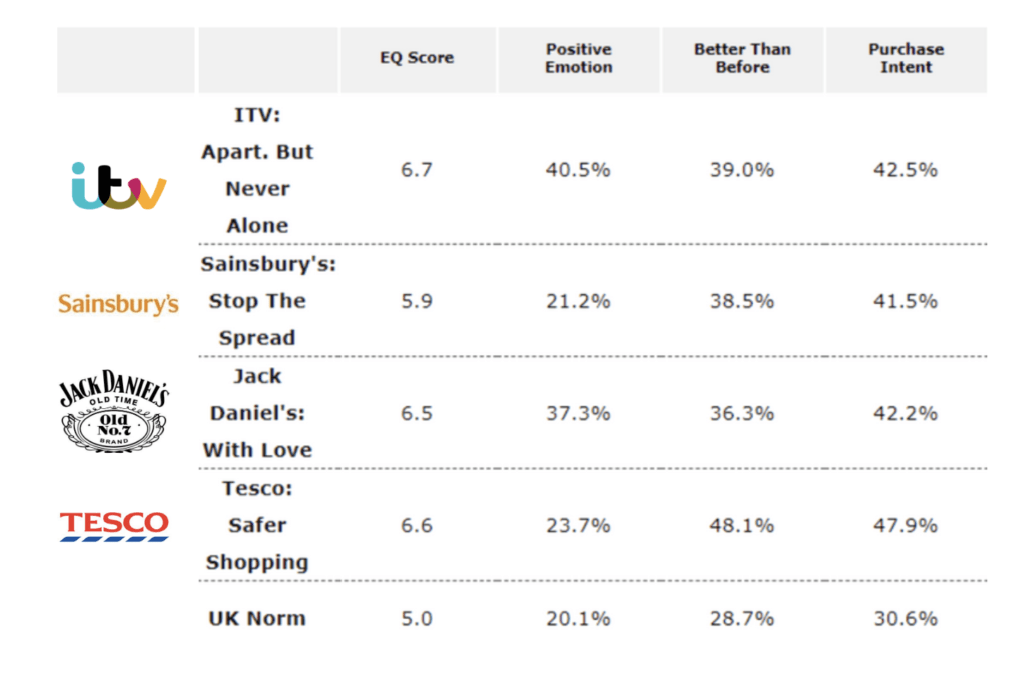
If you’d like to find out more about how we can help, please reach out to us at hi@unrulygroup.com or click here.
